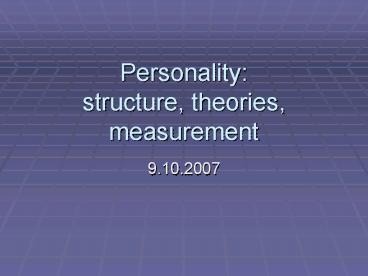Personality: structure, theories, measurement - PowerPoint PPT Presentation
1 / 29
Title:
Personality: structure, theories, measurement
Description:
cool, reserved or warm, easy going. concrete thinking or abstract thinking ... TAT Thematic apperception test (Murray, 1943) Rozenzweig's Picture-frustration Study ... – PowerPoint PPT presentation
Number of Views:219
Avg rating:3.0/5.0
Title: Personality: structure, theories, measurement
1
Personality structure, theories, measurement
- 9.10.2007
2
How would you describe yourself?
- cool, reserved or warm, easy going
- concrete thinking or abstract thinking
- easily upset or calm, stable
- not assertive or dominant
- sober, serious or happy-go-lucky
- expedient or conscientious
- tough-minded or tender-minded
- trusting or suspicious
- practical or imaginative
- forthright or shrewd
- self-assured or apprehensive
- conservative or experimenting
- group-oriented or self-sufficient
- undisciplined or self-disciplined
- relaxed or tense, driven
3
Definition of personality
- Personality consists of all the relatively STABLE
and DISTINCTIVE styles of thought, behavior and
emotional response that characterize a persons
adaptations to surrounding circumstances.
4
2 questions
- Why dont people react in the same way to the
same situation? - early life experiences
- biological makeup
- learning
- Can we predict behavior? Does it depend on
personality traits or on situation? - is personality assessment meaningful?
5
Different personality theories
- psychoanalytic approach
- trait theories
- social cognitive approach
- humanistic approach
- evolutionary/biological approach
6
Psychoanalytic approach
- Sigmund Freud
- childhood experiences
- the role of unconscious in motivating human
actions
7
Trait theories
- What are fundamental elements of personality?
- A trait any relatively enduring way in which one
individual differs from another - stable in time
- consistent over situations
- their combination is the cause of the individual
differences
8
Social cognitive approach
- active, conscious aspects of our personality
- different ways in which individuals interpret
events - personality styles are shaped by observational
learning - self-efficacy
9
Humanistic approach
- emphasizes human potential for growth, creativity
and spontaneity - self-concept
10
Biological approaches
- evolutionary approach
- behavioral genetic approach
11
The structure of the personality
12
Assessment of personality
- observation
- interview
- rating
- personality inventory
- projective techniques
13
History of personality assessment
- Pseudosciences phrenology, physiognomy,
graphology
14
History of personality assessment
- Type theories
- Galen theory of body humors (sanguine,
choleric, melancholic, phlegmatic type) - Kretschmer, Lombroso, Sheldon body type
theories
15
Contemporary assessment of personality
- Trait theories
- Allport, Cattel
- (factor analysis)
- Hans Eysenck 3 dimensions, biological basis of
differences - Big Five
- no theory of development
- relies too heavily on simple mathematical
techniques - exaggerate the consistency of human behavior
- can lead to circular reasoning
16
Contemporary assessment of personality
- Humanistic theories
- self concept scales
- MMPI (empirical basis)
17
Projective Testing Techniques
18
Projective techniques
- not psychometric instruments
- used in clinical settings, special training
- study of personality and adjustment
- use symbolic, pictorial, verbal and expressive
stimuli - uncovering of covert, latent, unconscious
aspects of personality
19
The concept of projection
- unwittingly attributing ones own drives, needs,
perceptions, attitudes and style to others - giving meaning to relatively ambiguous or
unstructured stimuli by drawing upon ones own
private desires, traits, fears, and experience
20
Projective techniques disguised tests
- no awareness of psychological interpretation
- responses should be free of personal censorship
- dominant psychological characteristics are
hidden in the responses
21
Classification of projectives
- Frank, 1948
- what they require or seek to evoke from the
subject - constitutive
- constructive
- interpretive
- cathartic
- refractive
22
Rorschachs Ink blot test
23
(No Transcript)
24
Criticism
- Lack of satisfactory internal consistency, or
test-retest reliability. - Failure to provide cogent evidence for clinical
validity. - Failure of the individual Rorschach scoring
categories to relate to diagnosis. - Lack of prognostic, or predictive validity with
respect to the outcome of treatment, or later
behavior. - Individual differences between groups of normal
subjects. - Failure to find any significant relationships
between Rorschach scores and intelligence, or
creative ability.
25
Draw a person test
26
TAT Thematic apperception test (Murray, 1943)
27
Rozenzweigs Picture-frustration Study
28
Make a Picture Story
29
Thank you for your attention!

